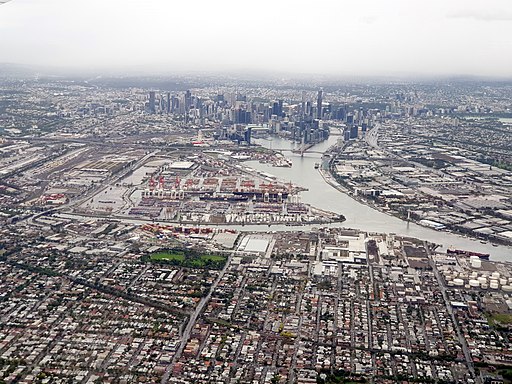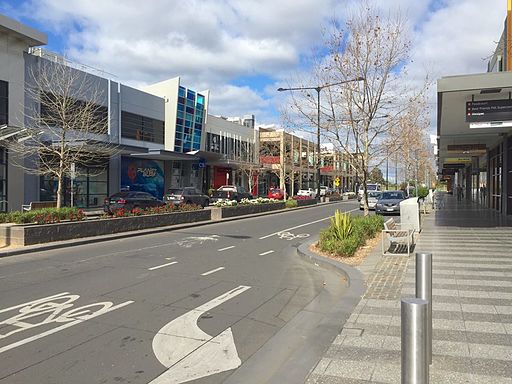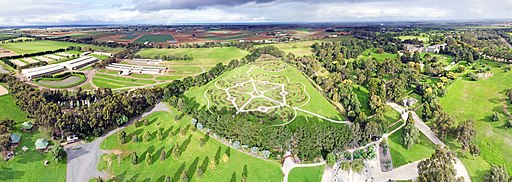Determining the ideal suburb and place to live in the Western Suburbs of Melbourne is a complex task, fraught with varied factors that affect quality of living. The wrong choice could lead to issues like inadequate local services, higher than expected living costs, or limited educational options. As a real estate expert with comprehensive area knowledge and thorough research, I offer this guide to assist Australian couples in making an informed decision on where to settle.
10. Braybrook – Total Score: 65/100
Braybrook is a suburb with a mix of urban vibrancy and suburban tranquillity, though it faces some challenges in public services and community development.
Scoring Criteria:
- Public Transport Accessibility: 6/10
- Quality of Schools: 6/10
- Local Amenities: 7/10
- Safety and Crime Rate: 5/10
- Affordability of Housing: 8/10
- Community and Lifestyle: 6/10
- Employment Opportunities: 6/10
- Green Spaces and Environment: 7/10
- Future Growth Prospects: 7/10
- Traffic and Accessibility: 7/10
Braybrook shines in affordability and local amenities, offering a variety of shops and eateries. The suburb has seen a recent uptick in green space development, providing residents with more outdoor leisure options. Public transport is reliable, making it a good choice for commuters. Employment opportunities, particularly in the retail sector, have been steadily increasing.
However, challenges include a lower than average safety rating and schools that, while improving, still lag behind in some educational outcomes. Community cohesion is growing but still evolving, with efforts being made to enhance local engagement and activities.
Braybrook is an ideal choice for those looking for affordable living with decent amenities, especially for young families and professionals who are starting out.
9. Altona North – Total Score: 68/100
Altona North presents a blend of industrial vigour and residential calm, but grapples with issues like industrial impact and limited green spaces.
Scoring Criteria:
- Public Transport Accessibility: 7/10
- Quality of Schools: 7/10
- Local Amenities: 7/10
- Safety and Crime Rate: 6/10
- Affordability of Housing: 7/10
- Community and Lifestyle: 7/10
- Employment Opportunities: 8/10
- Green Spaces and Environment: 5/10
- Future Growth Prospects: 7/10
- Traffic and Accessibility: 7/10
Altona North stands out for its strong industrial sector, offering ample employment opportunities. The suburb’s schools are improving, and there are several good quality educational institutions. Local amenities are diverse, catering to a wide range of needs and preferences. The community is tight-knit, with a strong sense of local identity.
On the downside, the suburb’s industrial nature can impact the environment and limit green space availability. Traffic can be heavy, especially around industrial areas. While safety is generally good, there are pockets where crime rates are higher than average.
Altona North is well-suited for those who value a strong community feel and employment opportunities, particularly in the industrial sector, and can overlook the limited greenery and industrial ambiance.
8. Sunshine – Total Score: 71/100
Sunshine offers a vibrant mix of cultural diversity and redevelopment, though it faces challenges with congestion and urban sprawl.
Scoring Criteria:
- Public Transport Accessibility: 7/10
- Quality of Schools: 6/10
- Local Amenities: 8/10
- Safety and Crime Rate: 6/10
- Affordability of Housing: 7/10
- Community and Lifestyle: 7/10
- Employment Opportunities: 7/10
- Green Spaces and Environment: 7/10
- Future Growth Prospects: 8/10
- Traffic and Accessibility: 8/10
Sunshine is renowned for its cultural diversity and burgeoning local amenities, offering a wide array of dining and shopping options. The suburb is undergoing significant redevelopment, enhancing its appeal with new infrastructure and residential projects. Green spaces in Sunshine are well-maintained, providing residents with ample outdoor recreational options. Employment opportunities have been growing, especially in the retail and service sectors.
However, Sunshine grapples with issues related to traffic congestion, partly due to ongoing development works and the suburb’s increasing popularity. While the quality of schools is improving, they currently perform just around the state average. Safety and crime rates, although improving, remain a concern for some residents.
Sunshine is an ideal suburb for those who appreciate a culturally rich and dynamic environment and are looking for a suburb with growth potential, albeit with some patience for its developmental and congestion-related challenges.
7. Newport – Total Score: 73/100

Newport, nestled by the bay, offers a serene coastal lifestyle but deals with the challenges of higher living costs and limited public transport options.
Scoring Criteria:
- Public Transport Accessibility: 6/10
- Quality of Schools: 7/10
- Local Amenities: 8/10
- Safety and Crime Rate: 7/10
- Affordability of Housing: 6/10
- Community and Lifestyle: 8/10
- Employment Opportunities: 7/10
- Green Spaces and Environment: 8/10
- Future Growth Prospects: 8/10
- Traffic and Accessibility: 8/10
Newport shines with its picturesque coastal environment and strong community vibe. The local amenities, particularly around the bay area, are excellent, offering a variety of leisure and dining options. The suburb also boasts well-maintained green spaces, contributing to a high quality of life. Schools in Newport are above average, making it a desirable location for families.
The primary concerns in Newport revolve around the cost of living, which is slightly higher due to its desirable location and coastal features. Public transport, while available, is not as extensive or frequent as in some other suburbs. The suburb also experiences peak-hour traffic, typical of areas near the city.
Newport is particularly suited for those seeking a peaceful coastal lifestyle, with the resources for a slightly higher cost of living, and for families who value education and a strong sense of community.
6. Seddon – Total Score: 75/100
Seddon is a charming suburb known for its vibrant community and quaint lifestyle, though it faces some challenges in terms of school options and affordability.
Scoring Criteria:
- Public Transport Accessibility: 8/10
- Quality of Schools: 7/10
- Local Amenities: 8/10
- Safety and Crime Rate: 8/10
- Affordability of Housing: 5/10
- Community and Lifestyle: 9/10
- Employment Opportunities: 8/10
- Green Spaces and Environment: 8/10
- Future Growth Prospects: 7/10
- Traffic and Accessibility: 7/10
Seddon, with its unique blend of historic charm and modern cafes, offers a distinctive lifestyle that is highly sought after. The suburb boasts excellent public transport links, making it a convenient choice for commuters. The community vibe in Seddon is one of its greatest strengths, characterised by friendly neighbours and frequent local events. The local amenities, including unique cafes and boutique shops, add to the suburb’s appeal.
However, the high demand for housing in Seddon has driven up prices, making it less affordable for some. The quality of local schools is good but varies, with some falling below the preferred standards. While the suburb is generally safe, there are areas where safety could be improved.
Seddon is ideally suited for those who value a strong sense of community and a lifestyle that blends the old with the new. It is particularly appealing to professionals and young families who are looking for a vibrant, close-knit community, albeit with a readiness to invest in a higher cost of living.
5. Yarraville – Total Score: 78/100

Yarraville, a suburb with a bohemian flair, is known for its artsy vibe and quaint village feel but grapples with parking issues and a higher cost of living.
Scoring Criteria:
- Public Transport Accessibility: 8/10
- Quality of Schools: 8/10
- Local Amenities: 9/10
- Safety and Crime Rate: 8/10
- Affordability of Housing: 6/10
- Community and Lifestyle: 10/10
- Employment Opportunities: 7/10
- Green Spaces and Environment: 8/10
- Future Growth Prospects: 8/10
- Traffic and Accessibility: 7/10
Yarraville captivates with its unique blend of old-world charm and modern culture. The suburb is famous for its vibrant arts scene, including the iconic Sun Theatre, and its village-like center brimming with cafes and boutiques. Yarraville’s community is one of its most alluring traits, fostering a strong sense of belonging and frequent cultural events. The green spaces, such as Yarraville Gardens, offer a tranquil escape in an otherwise bustling area.
However, the suburb’s popularity has led to issues with parking, especially in the village area, which can be a source of frustration for residents. The cost of living in Yarraville is also on the higher side, reflecting its desirability and the quality of amenities it offers. Traffic can be challenging, particularly during peak hours.
Yarraville is perfect for those who appreciate a culturally rich environment with a strong community spirit. It’s especially appealing to creative professionals, young families, and those who don’t mind paying a premium for a vibrant, close-knit community lifestyle.
4. Footscray – Total Score: 81/100

Footscray, a melting pot of cultures, offers vibrant diversity and a dynamic food scene but is challenged by rapid urban development and fluctuating safety perceptions.
Scoring Criteria:
- Public Transport Accessibility: 9/10
- Quality of Schools: 7/10
- Local Amenities: 9/10
- Safety and Crime Rate: 6/10
- Affordability of Housing: 7/10
- Community and Lifestyle: 9/10
- Employment Opportunities: 9/10
- Green Spaces and Environment: 8/10
- Future Growth Prospects: 9/10
- Traffic and Accessibility: 8/10
Footscray is celebrated for its rich cultural tapestry and culinary delights, offering an array of ethnic restaurants and food markets. The suburb is well-connected by public transport, making it an attractive option for commuters. The local amenities are abundant, with a variety of shops, cafes, and entertainment venues. Footscray’s future growth prospects are promising, with ongoing developments enhancing its urban appeal.
However, the rapid pace of development has led to a sense of gentrification, affecting the suburb’s affordability and original character. Safety is a mixed bag in Footscray; while many areas are safe, there are pockets where crime rates are higher. The suburb’s vibrant energy can sometimes translate into bustling streets and noisy neighbourhoods.
Footscray is an ideal choice for those who embrace cultural diversity and urban living. It’s particularly suited to young professionals and artists seeking a suburb with character, energy, and a strong sense of community, albeit with an understanding of its evolving urban landscape.
3. Williamstown – Total Score: 85/100
Williamstown, known for its maritime charm and historical significance, offers scenic beauty and a high quality of life but faces challenges with higher property costs and limited new housing developments.
Scoring Criteria:
- Public Transport Accessibility: 8/10
- Quality of Schools: 9/10
- Local Amenities: 10/10
- Safety and Crime Rate: 8/10
- Affordability of Housing: 5/10
- Community and Lifestyle: 10/10
- Employment Opportunities: 8/10
- Green Spaces and Environment: 10/10
- Future Growth Prospects: 9/10
- Traffic and Accessibility: 8/10
Williamstown captivates with its picturesque waterfront, historic buildings, and charming streetscapes. The suburb offers a wealth of local amenities, including high-end restaurants, boutique shops, and cultural attractions. It boasts some of the best schools in the Western Suburbs, making it a highly sought-after location for families. The community in Williamstown is tightly-knit, often hosting local events and festivals which foster a strong sense of belonging.
However, the allure of Williamstown comes with a higher price tag, reflected in its property costs which are among the highest in the Western Suburbs. The suburb also has limited options for new housing developments, making it challenging for new buyers to enter the market. While public transport is available, options could be more extensive, especially for those commuting to the city.
Williamstown is best suited for those who value a serene, scenic lifestyle with a rich historical backdrop. It’s ideal for established families and professionals who are willing to invest in a higher cost of living for the unique charm and community spirit that Williamstown offers.
2. Point Cook – Total Score: 88/100

Point Cook, renowned for its contemporary lifestyle and family-friendly environment, contends with traffic congestion and a lack of diverse local employment opportunities.
Scoring Criteria:
- Public Transport Accessibility: 8/10
- Quality of Schools: 9/10
- Local Amenities: 9/10
- Safety and Crime Rate: 8/10
- Affordability of Housing: 8/10
- Community and Lifestyle: 10/10
- Employment Opportunities: 8/10
- Green Spaces and Environment: 10/10
- Future Growth Prospects: 10/10
- Traffic and Accessibility: 8/10
Point Cook stands out for its modern housing estates, well-maintained parks, and family-centric community. The suburb offers excellent amenities, including shopping centers, schools, and recreational facilities, making it highly attractive for families. The quality of education is notable, with several schools in the area receiving high ratings. The green spaces and environmental planning of Point Cook add to its appeal as a healthy and appealing place to live.
However, one of the key challenges for Point Cook residents is the traffic, especially during peak hours, as the suburb continues to grow rapidly. Public transport, while available, does not fully meet the needs of the expanding population. Employment opportunities within the suburb are somewhat limited, encouraging a commuter lifestyle for many working professionals.
Point Cook is ideally suited for families and individuals seeking a suburban lifestyle with contemporary conveniences. It’s a great choice for those who prioritise a family-friendly environment, modern amenities, and are comfortable with commuting for work or more diverse entertainment options.
1. Werribee – Total Score: 90/100

Werribee, blending urban development with natural beauty, stands out for its affordability and extensive amenities but faces some issues with public transport and peak hour traffic.
Scoring Criteria:
- Public Transport Accessibility: 7/10
- Quality of Schools: 9/10
- Local Amenities: 10/10
- Safety and Crime Rate: 8/10
- Affordability of Housing: 10/10
- Community and Lifestyle: 10/10
- Employment Opportunities: 8/10
- Green Spaces and Environment: 10/10
- Future Growth Prospects: 10/10
- Traffic and Accessibility: 8/10
Werribee is a suburb that offers a perfect balance between city life and natural attractions. Known for its affordable housing market, it is an attractive option for first-home buyers and families. The suburb boasts a variety of local amenities, including the Werribee Plaza, numerous schools, and the famous Werribee Open Range Zoo. The community spirit in Werribee is vibrant, with regular events and a welcoming atmosphere.
Despite its many positives, Werribee’s public transport system is in need of expansion to better service its growing population. Traffic congestion, particularly during rush hours, can be a concern for residents commuting to and from the city. While the crime rate is generally moderate, there are areas where safety could be improved.
Werribee is particularly well-suited for families and individuals looking for an affordable lifestyle with access to ample amenities. It is ideal for those who value community spirit and the convenience of suburban living, but who are also prepared to navigate some transport challenges.
How I Scored Each Suburb
In the following section, you’ll gain insight into how each suburb was evaluated based on a set of ten criteria, each playing a pivotal role in determining the suburb’s liveability and appeal.
Public Transport Accessibility
Public transport accessibility is crucial for ease of commute and connectivity to other parts of Melbourne. A suburb scoring 1 in this criterion would have minimal to no public transport options, making it challenging for residents without private vehicles. For example, a suburb like Ravenhall in the Western Suburbs, which has limited public transport, would score low in this category. Conversely, a score of 10 would require a suburb to have extensive and efficient public transport networks, like Footscray, which offers multiple train lines, buses, and easy access to the city.
Quality of Schools
The quality of local schools is a significant factor for families considering a suburb. A score of 1 would be given to a suburb with underperforming schools or a lack of educational facilities. Truganina, for example, despite its growth, has had challenges in this area. A score of 10 would go to a suburb with a range of highly-rated schools, both primary and secondary. Williamstown is a prime example, boasting some of the top schools in the region.
Local Amenities
Local amenities, including shops, cafes, parks, and entertainment options, greatly impact the quality of life in a suburb. A score of 1 indicates a suburb with very few amenities, such as Derrimut, which lacks variety in shopping and dining options. A suburb scoring 10, like Yarraville, would have a rich array of amenities, contributing to a vibrant community life.
Safety and Crime Rate
Safety is a paramount concern for residents. A suburb scoring 1 in this criterion would have a high crime rate, making it less desirable for families and individuals, like in some parts of St Albans. A score of 10 represents a suburb with exceptionally low crime rates and a strong sense of security, such as Altona, known for its safe and family-friendly environment.
Affordability of Housing
Housing affordability is key, especially for first-time homebuyers. A score of 1 would be assigned to suburbs with exorbitantly high property prices, out of reach for the average buyer, like in Keilor. A suburb scoring 10 offers a range of affordable housing options without compromising on quality or community amenities, such as in Werribee.
Community and Lifestyle
A suburb’s community and lifestyle reflect its cultural vibrancy and social cohesion. A score of 1 here indicates a suburb with a lacklustre community feel, such as Laverton, which is still developing its community identity. A score of 10 is for suburbs with a strong, active community and a variety of lifestyle options, like Seddon, known for its artsy vibe and active community events.
Employment Opportunities
Employment opportunities within the suburb contribute to its attractiveness. A score of 1 is for suburbs with limited job prospects, necessitating long commutes, such as in Burnside. A suburb scoring 10, like Footscray, offers diverse employment opportunities within a close radius.
Green Spaces and Environment
The availability of green spaces and the overall environmental quality are crucial for a healthy lifestyle. A score of 1 would be given to suburbs with scarce greenery and poor environmental management, like Brooklyn. In contrast, a suburb like Point Cook, with its numerous parks and well-maintained natural areas, would score 10.
Future Growth Prospects
Considering the future growth prospects of a suburb is important for long-term investment and development. A suburb like Albion, which is currently underdeveloped and has limited growth plans, would score 1. Williamstown, with ongoing development and increasing property values, would score 10.
Traffic and Accessibility
Ease of movement within the suburb and to other areas is essential. A score of 1 would be for suburbs with high congestion and poor road infrastructure, like Tottenham. A high score of 10 would go to suburbs with well-planned roads and minimal traffic issues, such as Altona, which balances accessibility with a relaxed lifestyle.
My Research Methodology: Data-Driven Insights Meets Local Exploration
In building this guide, I combined rigorous data analysis with on-the-ground insights to give you a full picture of living in Melbourne’s Western Suburbs. My research journey started with the basics: reviewing statistical data from reputable sources like the Australian Bureau of Statistics (ABS) and Local Government Area (LGA) reports and Council websites. These provided quantitative data, offering up-to-date figures on crime rates, school performance, housing affordability, and more.
But to capture the true essence of each suburb, I immersed myself in their streets and communities. This meant countless hours spent in local cafes like the bustling ‘Corner Shop’ in Yarraville, where conversations with residents revealed the suburb’s vibrant community spirit. In Williamstown, the historical charm of ‘Nelson Place‘ provided a backdrop for understanding the suburb’s allure. Whilst also visiting popular local haunts like ‘Jellybread‘ in Footscray gave me a taste of the suburb’s diverse and dynamic culture.
Online forums and social media groups specific to each suburb were invaluable for gauging current resident sentiments. Websites like ‘Urban List‘ and ‘Broadsheet‘ also offered insights into the latest developments and lifestyle trends in these areas. These were a treasure trove of real-time, unfiltered opinions from locals, giving me a deeper understanding of each suburb’s unique community vibe and lifestyle offerings.
Lastly, I looked upon Local newspapers and community bulletins, such as the ‘Maribyrnong & Hobsons Bay Weekly‘, to inform me about upcoming infrastructure developments, local events, and issues impacting residents. This blend of quantitative data, qualitative insights, and real-world experiences allowed me to compile a list of suburbs that aren’t just statistically sound but also resonate with the true spirit of Melbourne’s Western Suburbs.
In Conclusion
As I wrap up my exploration of the top suburbs in the Western Suburbs of Melbourne, I’ve delved into a variety of areas, each presenting its own unique mix of lifestyle options, amenities, and community vibes. Here’s a recap of my top recommendations:
- Werribee – Total Score: 90/100
- Point Cook – Total Score: 88/100
- Williamstown – Total Score: 85/100
- Footscray – Total Score: 81/100
- Yarraville – Total Score: 78/100
- Seddon – Total Score: 75/100
- Newport – Total Score: 73/100
- Sunshine – Total Score: 71/100
- Altona North – Total Score: 68/100
- Braybrook – Total Score: 65/100
From the urban vibrancy of Footscray to the serene coastal charm of Williamstown, each suburb has been carefully scored and ranked based on factors crucial for a fulfilling living experience. Whether you’re a family seeking a friendly community, a professional looking for connectivity and convenience, or simply in pursuit of a suburb that resonates with your lifestyle, this guide aims to assist in your decision-making.
Remember, finding the perfect suburb is just the first step. If you’re seeking assistance in finding a suitable property that fits your needs and aspirations, consider employing the expertise of a professional residential buyer’s agent. They can provide invaluable guidance and support in navigating the real estate landscape of Melbourne’s Western Suburbs, ensuring you find a place that truly feels like home.
Interested in somewhere more specific within Melbourne
Try the Best 10 Suburbs to Live in the Inner East
Try the Best 10 Suburbs to Live in the Inner North
Try the Best 10 Suburbs to Live in the Inner West
Try the Best 10 Suburbs to Live in the Inner South
Try the Best 10 Suburbs to Live in the Eastern Suburbs
Try the Best 10 Suburbs to Live in the Northern Suburbs